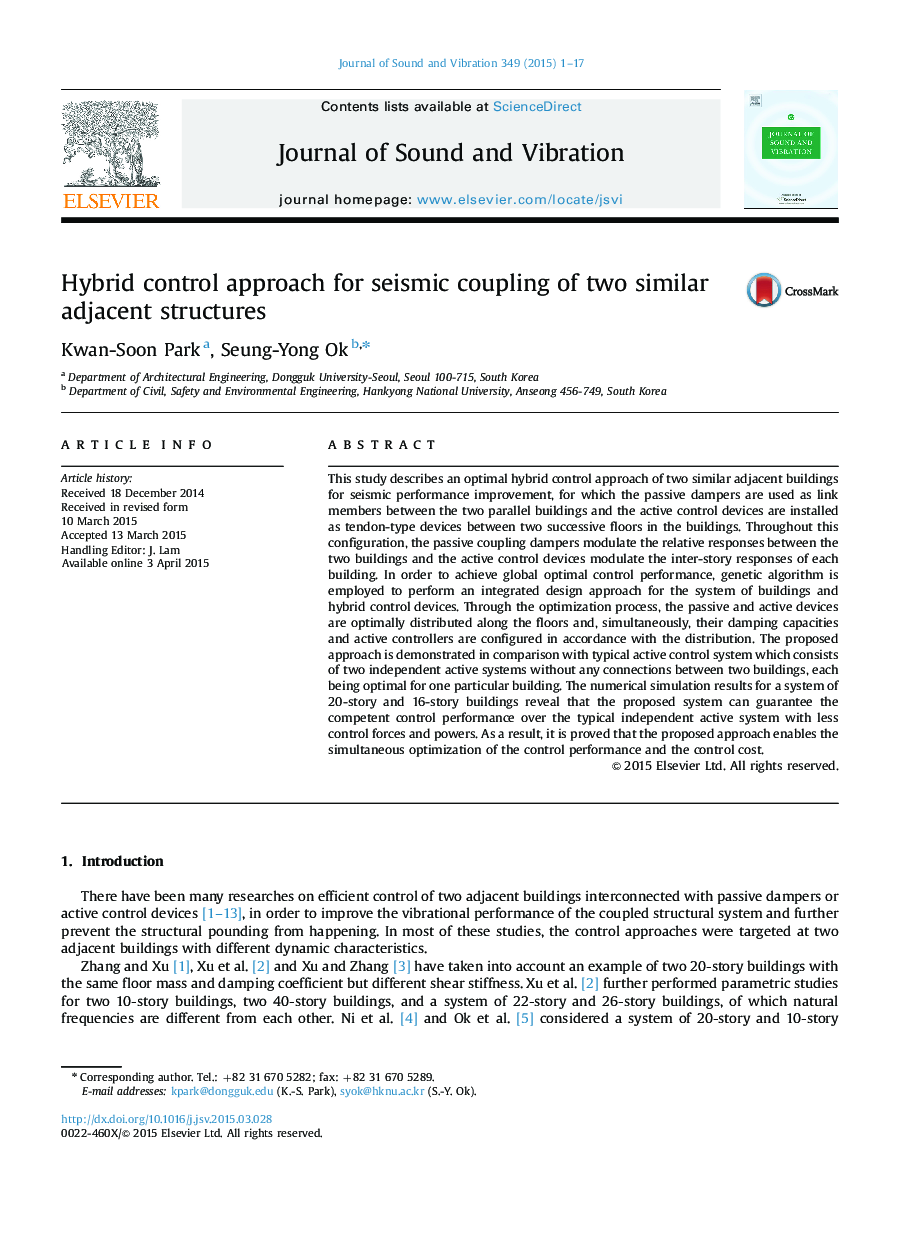| کد مقاله | کد نشریه | سال انتشار | مقاله انگلیسی | نسخه تمام متن |
|---|---|---|---|---|
| 6755639 | 509548 | 2015 | 17 صفحه PDF | دانلود رایگان |
عنوان انگلیسی مقاله ISI
Hybrid control approach for seismic coupling of two similar adjacent structures
ترجمه فارسی عنوان
روش کنترل ترکیبی برای ترکیب لرزه ای دو ساختار مجاور مشابه
دانلود مقاله + سفارش ترجمه
دانلود مقاله ISI انگلیسی
رایگان برای ایرانیان
ترجمه چکیده
این مطالعه یک رویکرد کنترل ترکیبی بهینه از دو ساختمان مجاور مشابه برای بهبود عملکرد لرزه ای را توصیف می کند که در آن، آرگون های غیرفعال به عنوان عضو پیوند بین دو ساختمان موازی و دستگاه های کنترل فعال به عنوان دستگاه های تاندون بین دو طبقه متوالی در ساختمان ها. در طول این پیکربندی، گیربکس های غیر فعال مخالف، واکنش های نسبی بین دو ساختمان و دستگاه های کنترل فعال را تعدیل می کنند و واکنش های بین داستان هر ساختمان را مدول می کنند. به منظور دستیابی به عملکرد مطلوب کنترل جهانی، الگوریتم ژنتیک برای انجام رویکرد طراحی یکپارچه برای سیستم ساختمان ها و دستگاه های کنترل ترکیبی مورد استفاده قرار می گیرد. از طریق فرایند بهینه سازی، دستگاه های منفعل و فعال به طور مطلوب در طول طبقه توزیع می شوند و به طور همزمان ظرفیت های میرایی و کنترل کننده های فعال مطابق با توزیع پیکربندی می شوند. رویکرد پیشنهادی در مقایسه با سیستم کنترل فعال معمولی که شامل دو سیستم مستقل فعال بدون هیچ گونه ارتباط بین دو ساختمان است، هر کدام برای یک ساختمان خاص مناسب هستند. نتایج شبیه سازی عددی برای سیستم ساختمان های 20 طبقه و 16 طبقه نشان می دهد که سیستم پیشنهادی می تواند عملکرد کنترل صحیح را در سیستم معمولی مستقل فعال با نیروهای و قدرت کنترل کمتری تضمین کند. در نتیجه، ثابت شده است که رویکرد پیشنهادی، امکان بهینه سازی همزمان عملکرد کنترل و هزینه کنترل را فراهم می کند.
موضوعات مرتبط
مهندسی و علوم پایه
سایر رشته های مهندسی
مهندسی عمران و سازه
چکیده انگلیسی
This study describes an optimal hybrid control approach of two similar adjacent buildings for seismic performance improvement, for which the passive dampers are used as link members between the two parallel buildings and the active control devices are installed as tendon-type devices between two successive floors in the buildings. Throughout this configuration, the passive coupling dampers modulate the relative responses between the two buildings and the active control devices modulate the inter-story responses of each building. In order to achieve global optimal control performance, genetic algorithm is employed to perform an integrated design approach for the system of buildings and hybrid control devices. Through the optimization process, the passive and active devices are optimally distributed along the floors and, simultaneously, their damping capacities and active controllers are configured in accordance with the distribution. The proposed approach is demonstrated in comparison with typical active control system which consists of two independent active systems without any connections between two buildings, each being optimal for one particular building. The numerical simulation results for a system of 20-story and 16-story buildings reveal that the proposed system can guarantee the competent control performance over the typical independent active system with less control forces and powers. As a result, it is proved that the proposed approach enables the simultaneous optimization of the control performance and the control cost.
ناشر
Database: Elsevier - ScienceDirect (ساینس دایرکت)
Journal: Journal of Sound and Vibration - Volume 349, 4 August 2015, Pages 1-17
Journal: Journal of Sound and Vibration - Volume 349, 4 August 2015, Pages 1-17
نویسندگان
Kwan-Soon Park, Seung-Yong Ok,
